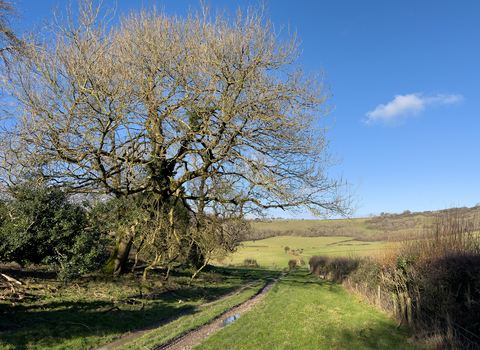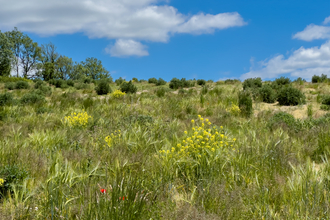A new chapter of landscape restoration
Building on its history as an organically managed farm, this remarkable landscape is now being restored and reimagined as a place where wildlife can thrive, natural processes can return and people can reconnect with nature. Our work at Lyscombe balances careful restoration and stewardship of the chalk downland Site of Special Scientific Interest (SSSI) with rewilding and natural regeneration across the wider, non-designated areas.
Over time, Lyscombe will evolve into a vibrant living mosaic of connected habitats—grazed grasslands, expanded woodlands, and freely flowing streams. Our long-term goal is for it to be recognised as a National Nature Reserve, showcasing biodiversity and nature recovery. Our vision is clear: to restore natural systems, support wildlife, and build a more resilient environment. By focusing on ecological processes and habitat restoration, we aim to let nature take the lead.
The transformation is already underway. Since acquiring Lyscombe just over a year ago, we've seen barn owls return, attracted by a resurgence of small mammals in the fields and hedgerows. It is already beginning to feel wilder. These early signs of recovery are a powerful testament to the land's resilience and its potential for regeneration.
Introducing Lyscombe (https://youtu.be/e18bHCgi9Rs)
Dorset Wildlife Trust
Latest updates from Lyscombe
At Lyscombe, our approach is rooted in landscape restoration. This means looking beyond isolated habitats to work at a broader scale—reviving ecological systems, reconnecting fragmented areas, and restoring the natural integrity of the entire site. A major milestone has been the removal of up to 23km of outdated fencing, opening up the landscape and enabling greater ecological connectivity. In its place, we’re installing carefully planned, long-lasting infrastructure to support conservation grazing. We’ve introduced English Longhorn cattle on the SSSI, where grazing plays a vital role in maintaining chalk grasslands, preventing scrub encroachment, and enhancing biodiversity. We’re drawing on lessons from our Wild Woodbury site near Bere Regis, where a diverse mix of grazing animals—including cattle, ponies, and pigs—has already begun to restore compacted soils and revive neglected grasslands by mimicking natural disturbance patterns.
River restoration is another central pillar of our plans. One of our most transformative projects will return the Little Piddle stream to its natural course after decades of modifications. By removing concrete culverts and outdated agricultural infrastructure, we aim to restore the Little Piddle valley—creating valuable wetland habitats and improving water quality for countless species. We’re also working closely with Historic England to preserve key heritage features, including the chapel and the ruined priest’s house, while restoring the site’s existing barns. To guide our restoration journey, Dorset Wildlife Trust has launched a comprehensive programme of wildlife monitoring and ecological surveys. From butterflies, bats, and breeding birds to invertebrates and small mammals, this research ensures our interventions are grounded in robust ecological evidence.
FAQs
What is special about Lyscombe?
In March 2024, Dorset Wildlife Trust and Natural England purchased 335 hectares of land at Lyscombe, 10 miles north-east of Dorchester. This monumental acquisition - one of the biggest in the Trust's history - was made possible through funding from Natural England's National Nature Reserves programme, and planned nutrient mitigation credit scheme, alongside generous donations from Dorset Wildlife Trust members and supporters. Nestled within the breathtaking Dorset National Landscape (formerly Dorset AONB), this expansive landscape boasts a treasure trove of chalk downland, lush scrub, vibrant wildflower meadows, and ancient woodlands. It holds a number of prestigious designations, including a 50-hectare Site of Special Scientific Interest (SSSI), a Site of Nature Conservation Interest (SNCI), and several Scheduled Monuments, including the unique Lyscombe Chapel. This land acquisition presents an exciting opportunity to create more space for nature and restore natural processes across the landscape whilst ensuring that the existing ecological and historic designations are protected and opening up more access for people to enjoy this stunning place.
Why did you buy this land?
There were three key reasons for acquiring this land.
First, we need nature more than ever. Dorset Wildlife Trust and our partner wildlife trusts are calling for 30% of our land and sea to be connected and protected for nature’s recovery by 2030. Making space for nature to become abundant will give our struggling wildlife the chance to recover, spread and thrive.
Second is tackling the climate crisis and contributing to our quality of life. Managing more land for nature and restoring natural processes increases the amount of carbon that can be held in healthy soils and woodlands. The creation of new wetlands can reduce the risk of flooding and reduce the nutrients flowing into our rivers and seas.
Third, the visually stunning location of Lyscombe lends itself well to engaging people and communities, enabling people to play a role in addressing the climate and ecological crises, contributing to our goal of one in four people taking action for nature. We will create opportunities for people of all backgrounds and abilities to learn about and enjoy nature and help to create a wildlife haven for everyone.
How was the acquisition funded?
This acquisition was made possible through funding from Natural England's National Nature Reserves programme, and planned nutrient mitigation credit scheme, alongside generous donations from Dorset Wildlife Trust’s members and supporters.
How is Natural England involved?
Whilst the primary interest of all the partners is to see the area managed for nature recovery, the more sustainable methods of land management at Lyscombe will also serve to reduce the levels of harmful nutrients entering Poole Harbour. Poole Harbour has been suffering for years from algal blooms, caused by excessive nutrients, originating from both land management like fertilisers and slurry and discharges from sewage treatment. Natural England's Nutrient Neutrality scheme is based on making a permanent management changes - ceasing nutrient inputs and arable cultivation in perpetuity.
By adopting a more sustainable form of land management, nutrients entering the top of the catchment at Lyscombe will be reduced both by removing inputs, and through natural recovery measures such as creating new wetland habitat that can capture nutrients.
What will happen to the SSSI?
One of our first priorities will be to assess the condition and survey the wildlife within the SSSI. With our considerable experience of managing nature reserves across Dorset, we will maintain and enhance the habitat using traditional conservation management techniques. Our aim is to establish Lyscombe as a national exemplar nature restoration initiative. It will demonstrate a pioneering approach to combining the management and enhancement of important heritage habitats with rewilding and natural regeneration techniques to transform the land into a wildlife-rich core area for nature recovery across the wider Dorset Downs landscape.
What are the Scheduled Monuments at Lyscombe?
There are a number of Scheduled Monuments and listed buildings on the site which include ancient earthworks and field systems, barrows and a delightful ancient chapel, the chancel of which dates to the twelfth century. The barrows and earthworks will be an important consideration in managing the site. We will work with Historic England, Dorset Council and Dorset National Landscapes to ensure that they are all managed appropriately.
Can I visit Lyscombe?
There is a small parking area at the main entrance to Lyscombe off Drake's Road - the postcode is DT2 7RF and and here is the what3words location. A number of public footpaths give access across the land and in particular, around the chalk bowl giving fine views across the Dorset countryside. Over time, we will consult and consider improvements to access and will be organising public events for the community and our members.
What are the plans for Lyscombe?
Dorset Wildlife Trust plans to make more space for wildlife to expand and thrive throughout this stunning landscape. We plan to use natural regeneration techniques and a rewilding approach blended with traditional conservation management to enhance and restore the habitats. We also look forward to improving visitor access to this stunning landscape, particularly on existing footpaths and rights of way to help local people and visitors to enjoy this incredibly special place.
We will undertake extensive ecological, soil, hydrological and other environmental surveys across the land to establish baselines and ongoing monitoring of invertebrates, small mammals, bats, breeding birds and flora to help inform and develop our land management plans. At the same time, we will be working on installing fencing and other infrastructure needed to facilitate low intensity mixed grazing across the SSSI and former arable land as well as the grasslands and woodlands. The intention is to allow much of the site to rewild using natural regeneration techniques, supplemented by appropriate tree planting. The land is likely to develop into a mosaic of grassland and scrubby wood pasture which will also require grazing with the associated infrastructure and animal welfare needs.
Alongside this, we plan to create new habitat to attract more wildlife onto the land. The Little Piddle, a tributary of the River Piddle, rises at Lyscombe which means ‘reedy valley’ in Old English. This presents an exciting opportunity to restore the river for wildlife and create fen meadows in the valley bottom, leading to a reduction of harmful nutrients flowing into Poole Harbour via the waterways.
Sign up for our e-newsletter
If you're interested in hearing more about Lyscombe and keeping up-to-date with all our Dorset wildlife news, why not subscribe to our e-newsletter.







